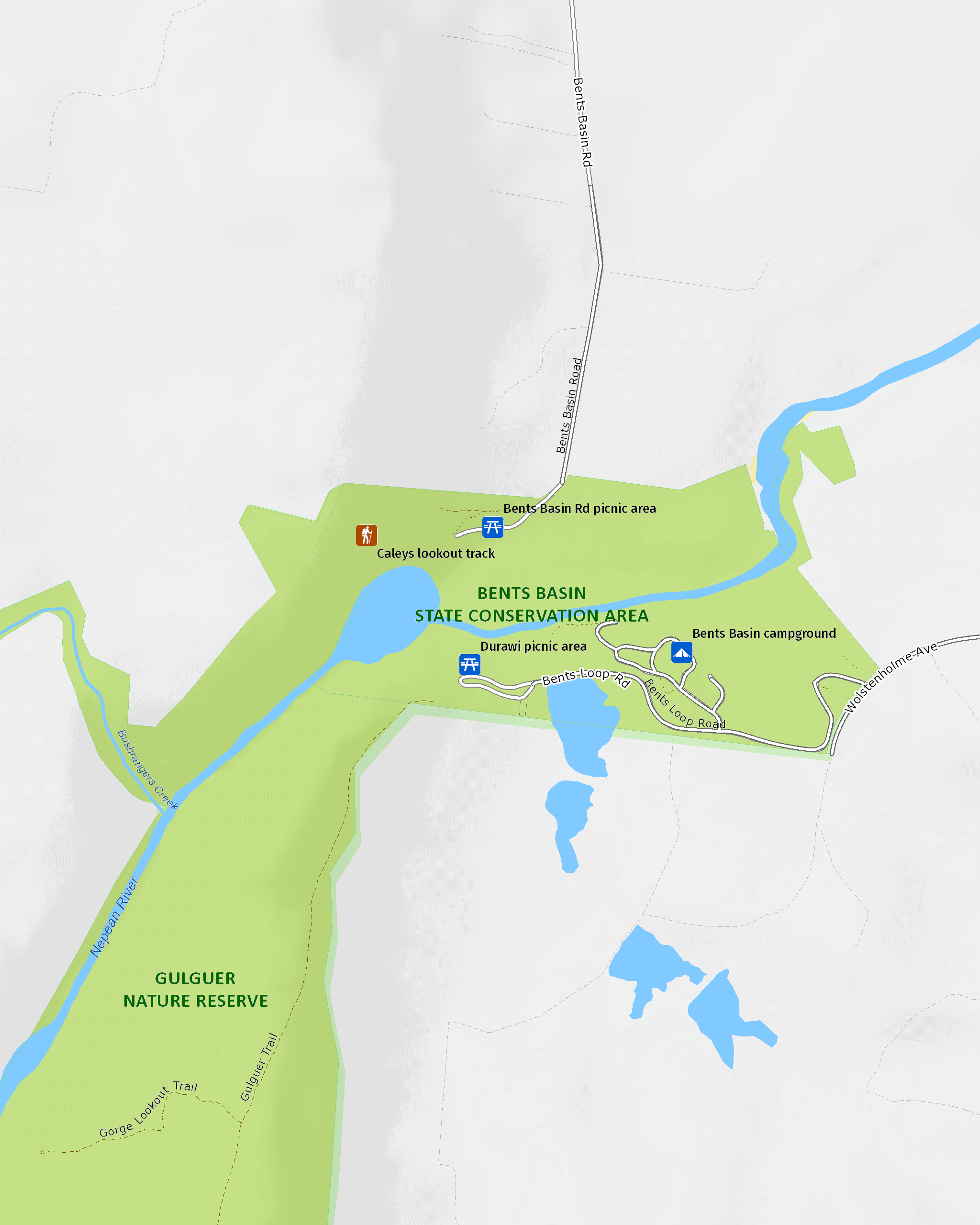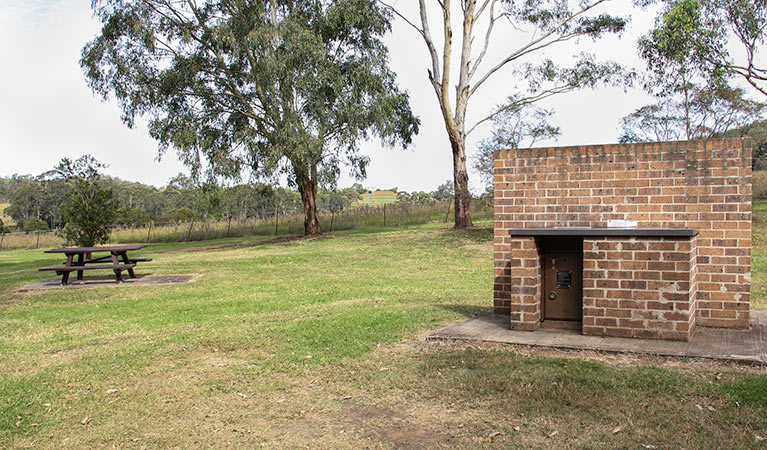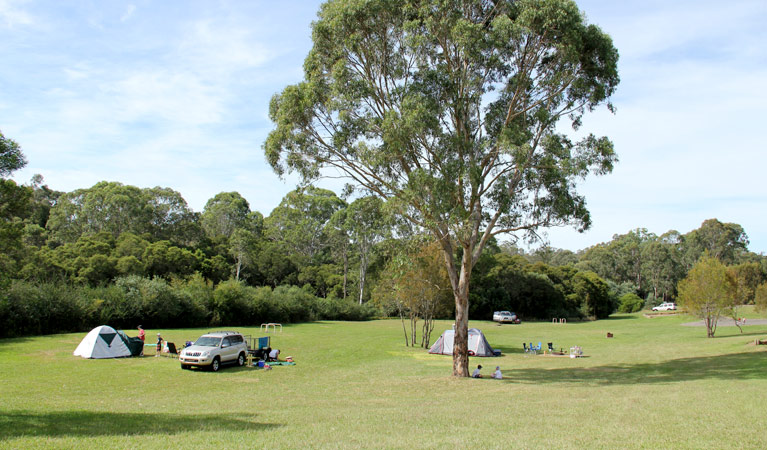Bents Basin campground
Bents Basin State Conservation Area
Overview
A great family camping spot in Sydney, Bents Basin campground offers sites for tents, trailer and caravans in a scenic location by the water – go fishing and kayaking.
| Camping type | Tent, Camper trailer site, Caravan site, Camping beside my vehicle |
|---|---|
| Where | 525 Wolstenholme Avenue, Greendale, NSW, 2745 - in Bents Basin State Conservation Area |
| Facilities | Amenities block, picnic tables, barbecue facilities, carpark, drinking water, public phone, showers, toilets, electric power |
| What to bring | Firewood, camping equipment, tent |
| Opening times | The entry gate to the campground on Wolstenholme Ave is locked daily from 6pm (May to August) or 8pm (September to April). Gate codes will be emailed after you book. |
| Entry fees |
Park entry fees are not included in your camping fees. |
| Group bookings | Book up to 20 people or 5 sites online. For larger groups, make a group booking enquiry. |
| Please note | Check in 2pm, check out before 10am. |
Bents Basin offers a camping experience that is within easy reach of urban Sydney suburbs. It’s an open, grassy campground bordered by trees on one side and featuring Bents Basin on the other.
Take your pick of campsites, pitch your tent or bring your caravan or trailer along. It’s a great choice whether you are going family camping or camping with a larger group.
Once you’ve set up camp, what you do next is up to you; relax by the Basin, take a walk along Caleys lookout track, go for a paddle or try your hand at fishing, or if you’re feeling hungry, start up the barbecue to cook your lunch.
You’ll find excellent facilities, including a camp kitchen ideal for group bookings and hot showers – a welcome luxury after a day exploring this park.
Map

Map

Map legend

Local alerts
For the latest updates on fires, closures and other alerts in this area, see https://uat.nswparks.cloud/camping-and-accommodation/campgrounds/bents-basin-campground/local-alerts
Bookings
- National Parks Contact Centre
- 7am to 7pm daily
- 1300 072 757 (13000 PARKS) for the cost of a local call within Australia excluding mobiles
- parks.info@environment.nsw.gov.au
Park info
- in Bents Basin State Conservation Area in the Sydney and surrounds region
Bents Basin State Conservation Area is open 8am to 6pm from May to August and 8am to 8pm from September to April. The park may have to close at times due to poor weather or fire danger.
-
Park entry fees:
$8 per vehicle per day. Day passes are available from on-park pay machines that accept coins and credit cards, and you can also pay for your visit via the Park’nPay app.
Buy annual pass.
Visitor info
All the practical information you need to know about Bents Basin campground.
Maps and downloads
Learn more
Bents Basin campground is in Bents Basin State Conservation Area. Here are just some of the reasons why this park is special:
Aboriginal heritage

Bents Basin State Conservation Area is the traditional land of the Gundungurra, Dharawal and Darug people. Also known as Gulguer (meaning whirlpool or spinning), Bents Basin is associated with an awful aquatic creature called Gurungadge or Gurungaty. This creature is prominent in the area's ancestral stories. Archaeological finds suggest the area was also an important trading place. Bents Basin and the adjoining Gulguer Nature Reserve protect a variety of Aboriginal rock art and artefacts.
Bygone days

Explorer and botanist George Caley was the first European to visit the area in 1802 and afterwards collected plant specimens for preservation. The area was later used as a stopping point for early settlers travelling from the developing east. If you're interested in the local history of western Sydney, be sure to check out the historic inn, established in the 1860's and listed on both the state and National Heritage Register, you'll find it near Peppercorn picnic area.
Fascinating and fun

The basin itself is what draws most people here. Known as a scour pool, this geological formation is like a small lake, created over time by fast-flowing floodwaters exiting the gorge about 30-40km/hr. At 22m deep, its waters travel 150km before reaching the ocean. In addition to that, it's heaps of fun to visit for a spot for swimming, fishing, paddling and liloing.
Rare communities

A visit to the park allows you to see majestic Camden white gums in one of only two known naturally-occurring populations. Look out also for Cumberland Plain woodland which once blanketed almost 30% of the Sydney Basin. Today, its scattered fragments cover less than 6% and remain under threat. Important fauna species include the regent honey eater, Cumberland Plain land snail, eastern bentwing bat, sooty owl and the glossy black cockatoo.
- Caleys lookout track Caleys lookout track is a short and steep walk through bushland of Bents Basin State Conservation Area near Penrith. Take your lunch – it’s a great spot for a picnic.
Plants and animals protected in this park
Animals
-

Brown-striped frog (Lymnastes peronii)
One of the most common frogs found in Australia, the ground-dwelling brown-striped frog lives in ponds, dams and swamps along the east coast. Also known as the striped marsh frog, this amphibian grows to 6.5cm across and has a distinctive ‘tok’ call that can be heard all year round.
-

Eastern snake-necked turtle (Chelodina longicollis)
Found across most of NSW, the eastern snake-necked turtle, also known as the eastern long-necked turtle, can be found in swamps, lakes and inland waterways. This freshwater turtle is carnivorous and lives most of its life submerged on the water’s edge, searching for worms and snails.
-

Common brushtail possum (Trichosurus vulpecula)
One of the most widespread of Australian tree-dwelling marsupials, the common brushtail possum is found across most of NSW in woodlands, rainforests and urban areas. With strong claws, a prehensile tail and opposable digits, these native Australian animals are well-adapted for life amongst the trees.
-

Eastern blue-tongue lizard (Tiliqua scinciodes)
The eastern blue-tongue lizard, one of the largest skinks in Australia, is found throughout most of NSW. When threatened, the eastern blue-tongue lizard displays its blue tongue in a wide-mouthed intimidating show. Not an agile animal, they feed on slow-moving beetles and snails.
-
Cumberland Plain land snail (Meridolum corneovirens)
The endangered Cumberland Plain land snail is only found on the Cumberland Plain, west of Sydney. During drought it digs deep into the soil to escape harsh conditions. Its brown shell is thin and fragile.

